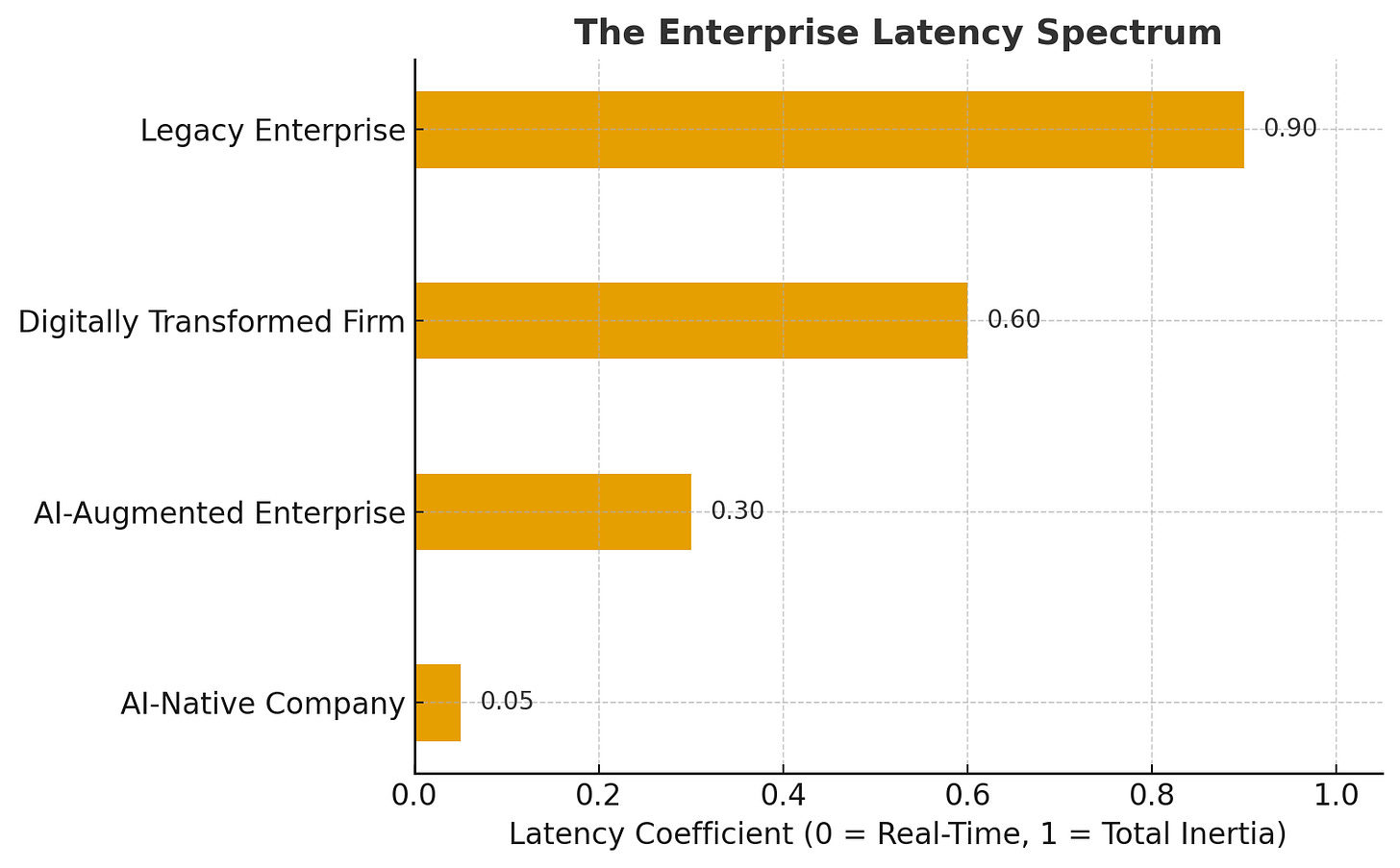What is Enterprise Latency
Enterprise latency is the invisible drag between customer expectations and operational execution, the gap between signal and response. It’s not a single bottleneck but the compounded friction of decision-making, coordination, and system lag that slows a company’s ability to act on information. In effect, it measures how long it takes for reality to move through an organization.
In legacy enterprises, this gap can stretch from days to months, a full order of magnitude slower than digital or AI-native firms. Benchmarks from DevOps and operational analytics show that high-performing organizations execute change cycles in hours to days, while low performers still operate on month-long cadences.1 In contrast, AI-native architectures, event-driven systems where data flows directly into automated decisions, respond in seconds or less.2 The difference isn’t incremental; it’s exponential, representing up to a 10⁴× speed differential in operational responsiveness.
But there’s no universal “latency coefficient.” Each industry and process carries its own physics: customer support may measure latency in minutes (mean time to resolution).3 At the same time, enterprise data systems think in seconds (real-time BI),4 and product organizations in weeks (lead time for change).5 Aggregating these gives only an interpretive spectrum, not a precision metric. Still, the pattern is unmistakable: as organizational scale increases and human oversight layers accumulate, responsiveness decays.
Enterprise latency, then, is less about technology than about architecture. It’s the byproduct of control systems designed for predictability rather than speed. In a market where advantage compounds at machine time, that trade-off has inverted. The firms winning today aren’t those with the most data or people, they’re those with the lowest friction between knowing and doing.

Introducing Zero Latency
The Zero-Latency Enterprise (ZLE) inverts the traditional paradigm. Instead of treating insight and execution as separate domains, it collapses them into a continuous, self-correcting operating loop. In a ZLE, data doesn’t just inform decisions, it drives them directly. Business logic, models, and execution are fused into a unified architecture where sensing, reasoning, and acting happen in real time, often without human intervention.
The result is an organization that behaves less like a hierarchy and more like a living system: it perceives changes in its environment, adapts instantly, and learns continuously. Customer behavior, supply fluctuations, or competitive moves become input signals that trigger automated responses, adjusting prices, reallocating resources, or optimizing workflows, all before management meetings can even be scheduled.
This model turns volatility into an advantage. What looks like chaos to a traditional firm becomes informational energy for a ZLE. Market turbulence, demand spikes, or supply shocks don’t require crisis management; they are data streams to be metabolized in real time. In effect, the ZLE transforms uncertainty into throughput.
Industry leaders experimenting with zero-latency architectures, particularly in logistics, fintech, and digital commerce, report tangible gains: double-digit improvements in operational efficiency, revenue velocity, and time-to-customer metrics.6 These gains don’t come from incremental automation, but from architectural inversion: replacing the human approval chain with autonomous decision loops. The strategic implication is profound — once latency approaches zero, strategy itself becomes execution.
Complexity in Retail
Retail operates at a staggering scale and velocity, with global revenue projected to reach $31.3 trillion by 2025 and millions of transactions flowing through digital and physical channels daily.
The environment is in constant flux: consumer preferences shift instantly, shaped by trends, viral content, and social sentiment. What sells today may be obsolete tomorrow. Every SKU, every promotion, every shelf position exists within a web of interdependent decisions, pricing, assortment, inventory, fulfillment, and marketing, all of which must align in real time to meet demand.
For example, a European grocery retailer may manage over 10,000 SKUs and thousands of daily customers. Each transaction represents billions of potential interactions across product combinations, promotions, and inventory locations. Human-led, batch-based systems cannot coordinate this complexity fast enough. Latency in decision-making manifests as stockouts, overstocks, misaligned pricing, and missed opportunities, and these errors compound continuously in an always-on market.
The challenge is not just scale; it’s multidimensional, real-time complexity. Retailers operate in a dynamic system where supply, demand, and operational constraints intersect constantly, making traditional approaches increasingly inadequate.
Why Zero-Latency Retail
Traditional retail was engineered for control and cost efficiency, not speed. Pricing, promotions, inventory, and logistics follow rigid weekly or seasonal cycles, creating built-in delays between market signals and operational response.
The consequences are systemic: stockouts when demand spikes, overstocks when it fades, promotions that miss cultural moments, and assortments that update too late. Each lag directly erodes revenue, inflates carrying costs, and weakens brand relevance.
Zero-Latency Retail flips this model. Pricing, inventory, logistics, and behavioral data feed into a unified, autonomous system that senses market signals and adapts continuously, reallocating stock, adjusting promotions, and optimizing assortment in real time.
Industry leaders are already proving the payoff. Walmart’s AI-driven supply chain forecasts demand dynamically, reallocating inventory and cutting waste. Amazon’s integrated ecosystem synchronizes pricing, inventory, and fulfillment in real time, reducing latency and maximizing throughput. These examples show that in retail, speed isn’t just operational, it’s strategic: zero latency turns complexity into advantage, transforming responsiveness into resilience, efficiency, and profit.
AI: The Engine for Zero Latency
Zero latency was once impossible. Traditional retail, like most industries, relied on human decision-making and periodic reporting cycles, which created an unavoidable lag between insight and action.
Decisions were filtered through layers of approval, scheduled around weekly or monthly cadences, and constrained by manual processes. The result: a constant drag on responsiveness, missed opportunities, and systemic inefficiency.
AI changes that equation entirely. It ingests continuous data streams, sales, customer behavior, sentiment, inventory, and supply signals, and channels them into autonomous decision layers that sense, reason, and act without human delay. Machine learning models detect emerging trends, anticipate demand shifts, and execute operational adjustments in real time. Replenishment cycles accelerate by up to 25%, lost sales shrink, and cash flow is freed, creating a measurable impact across the value chain.
The transformative factor is autonomy. AI doesn’t merely make humans faster: it removes slow coordination loops altogether, replacing them with self-learning systems capable of instant execution.
These systems continuously adapt, optimize, and correct themselves, compressing the latency chain from days or weeks down to minutes or seconds. The effect is a shift from reactive to predictive operations, where strategy and execution converge. Competitors bound by traditional processes struggle to match this responsiveness, giving zero-latency organizations a durable, hard-to-replicate advantage.
Data: The Roadblock to Zero Latency
The greatest barrier to zero latency isn’t AI: it’s data.
Retailers are entangled in a web of disconnected systems: POS, CRM, ERP, and cloud platforms that operate in isolation. As of 2025, 68% of business leaders identify data silos as the primary obstacle7 to real-time operations, hindering agility and responsiveness.
External data only amplifies the problem. Supplier inventories, payment flows, marketplace signals, and macroeconomic trends reside in incompatible systems, each governed by distinct taxonomies and ownership models. Compounding this, critical institutional knowledge, strategy, logic, and decision frameworks remain trapped in presentations and executives’ minds, inaccessible to machines.
Overcoming this barrier requires a unified data architecture. Internal and external signals, decision logic, and institutional knowledge must converge into a single, continuously updated intelligence layer. Only then can organizations dissolve operational drag, synchronize cross-functional processes, and operate with true zero-latency responsiveness.
Our Thesis
At One Ring Labs, we help retailers shift from reactive operations to real-time intelligence, transforming speed and adaptability into enduring competitive advantage.
Our philosophy is straightforward: zero latency begins with zero friction in data. AI cannot operate at full potential in fragmented organizations. To unlock its power, companies must be architected for seamless information flow, autonomous execution, and continuous learning.
Step 1: ARDA Transforms Your Enterprise into a Thinking System
We design and deploy unified data models that consolidate cross-functional sources, from POS and CRM to supply chain and marketing, into a single coherent data fabric: ARDA.
ARDA is the knowledge engine of the enterprise. It contextualizes and connects every internal and external signal, operational, financial, organizational, and market-facing, into a dynamic, continuously learning model of the business. This foundation enables context-aware intelligence and frictionless collaboration across the enterprise.
Step 2: 1R is the AI application for Collaborative Management
Sitting atop ARDA, 1R is the collaborative management layer that continuously optimizes the business in motion. It generates pre-built decisions and execution paths, which managers can review and deploy in real time.
1R represents the first step toward a zero-latency enterprise: a system where human judgment and machine intelligence converge, enabling organizations to sense, decide, and act with minimal latency.
We construct AI-native retail systems from the ground up, embedding autonomy and intelligence into every operational layer. Data architecture, machine learning, and automated decision execution are fused into a single real-time control loop, ensuring that every product, price, and interaction aligns with live market conditions.
By collapsing the gap between insight and execution, we help retailers convert latency into leverage, delivering measurable improvements in speed, precision, and profitability.
Initial Trials
Use Case: ARDA + 1R Applied to New Product Introduction (NPI)
Product Launch Lifecycle: Vendor Pitch → Retail Distribution
In traditional retail, the process starts when a vendor knocks on the door. The head of merchandising must decide, often on incomplete data, whether to list the product, where to sell it, in what quantities, and at what price. These decisions rely heavily on static forecasts, historical reports, and even if they have the budget for market and consumer intel, gut instinct, with little ability to test assumptions or validate demand before committing.
As a result, launches hinge on judgment calls made in an information vacuum. Products are over-ordered or under-distributed, and it can take weeks or months before performance data confirms whether those early decisions were right. The outcome: 15–20% revenue loss in the first few weeks from stockouts, overstocks, and assortment mismatches.
With ARDA + 1R, that process becomes dynamic, data-rich, and self-optimizing.
ARDA integrates live signals from sales, social sentiment, regional trends, and supply dynamics, giving the merchandiser a real-time, contextual view of potential demand.
1R, the autonomous decision layer, runs continuous simulations to recommend optimal assortments, pricing, and allocation strategies across the network, before the first unit ships, and to optimize the introduction’s success chances.
By the time the vendor finishes the pitch, the system can project expected sales, identify target stores, and suggest dynamic pricing based on live conditions. Once in market, 1R keeps adapting, reallocating inventory, adjusting promotions, and rebalancing distribution in real time.
This zero-latency operating model transforms distribution into a living, self-correcting system. Stockouts decline by 20%, inventory costs drop 15%, and replenishment cycles compress from weeks to hours, ensuring every product reaches its ideal customer, precisely when demand peaks.
Capturing Value, Securing Leadership
The journey to Zero latency is long, but every step yields measurable returns.
Deploying unified data layers, automating targeted processes, and integrating real-time behavioral and supply signals immediately compress operational lag, recover lost revenue, and prepare the organization for larger-scale transformation.
In a $31.3 trillion global retail market, even small efficiency gains translate into billions of dollars in reclaimed value, reduced waste, and smarter resource allocation.
The payoff extends beyond profit: it accelerates organizational learning, enhances responsiveness, and builds a foundation for sustainable, scalable growth.
Retailers investing in zero-latency architectures are not merely keeping pace; they are defining the frontier of market leadership. Latency is the invisible drag on relevance and profitability; erasing it is now a strategic imperative.
By unifying data ecosystems and deploying autonomous decision intelligence, organizations convert volatility into precise, real-time execution and execution into durable competitive advantage.
Zero-latency retail is no longer aspirational. It is the new operational baseline for growth, strategic leadership, and customer relevance in the intelligent economy.
- Team @ One Ring Labs
DORA: Accelerate State of DevOps Report (2021–2022).
Real-Time Business Intelligence, Wikipedia (2024 revision)
Customer Support Benchmarks, Intercom & MoveWorks (2024)
McKinsey, “Superagency in the Workplace” (2025).
HappyFox & industry MTTR benchmarks (2024)
McKinsey, “Superagency in the Workplace” (2025); Gartner, “Real-Time Enterprise Operating Models” (2024); DORA Report (2022)
Dataversity, “Data Strategy Trends in 2025: From Silos to Unified Enterprise Value” (2024)



